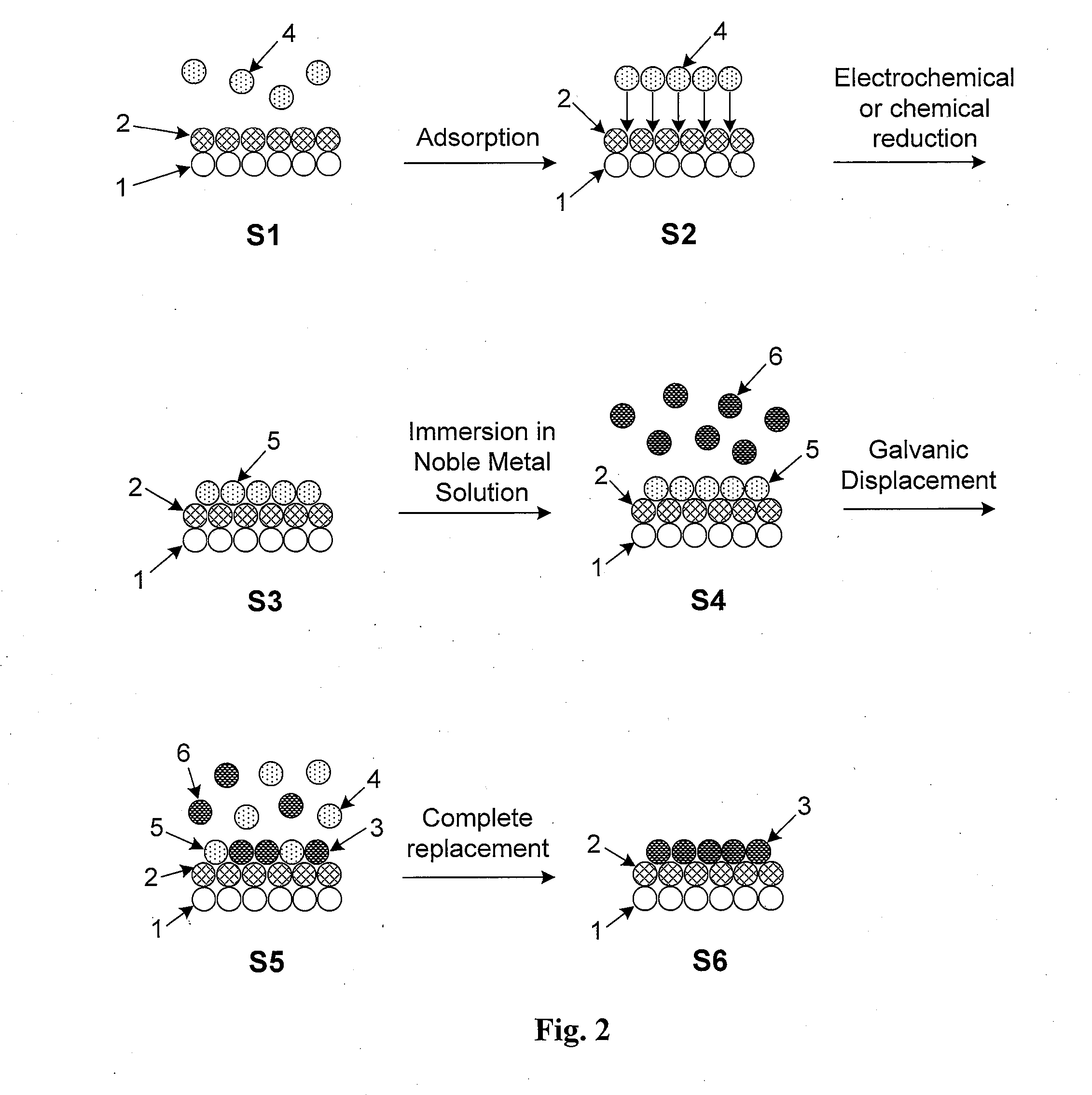Platinum-Coated Non-Noble Metal-Noble Metal Core-Shell Electrocatalysts
a core-shell electrocatalyst, non-noble metal technology, applied in the direction of metal/metal-oxide/metal-hydroxide catalysts, physical/chemical process catalysts, cell components, etc., can solve the problem of affecting the successful implementation of fuel cells in commercially available fuel cells, affecting the surface area available for reaction, and affecting the efficiency of forming
- Summary
- Abstract
- Description
- Claims
- Application Information
AI Technical Summary
Benefits of technology
Problems solved by technology
Method used
Image
Examples
example 1
[0070]In one embodiment sodium boronhydride is used to reduce a room-temperature suspension comprising PdCl2 and CoCl2 salts mixed in a 1:1 to 1:10 ratio. The sample is dried and then held in an inert or reducing environment at 600° C. for one hour to drive surface segregation of Pd atoms. For purposes of this embodiment, only the first two surface atomic layers of a self-protecting nanoparticle alloy are shown in FIG. 2. The nanoparticle surface in FIG. 2 shows a portion of the non-noble metal core (1) along with the noble metal shell (2) which, in this embodiment, are Co and Pd, respectively.
[0071]Non-noble metal ions of Cu2+ (4) are initially adsorbed on the surface by immersing the nanoparticles in a plating bath comprising the appropriate concentration of Cu2+ ions (4) in step S1. UPD of Cu results in the adsorption of Cu2+ ions (4) on the nanoparticle surface in step S2 and the formation of a monolayer of Cu (5) in step S3. This monolayer forms a continuous Cu “skin” around th...
example 2
[0073]In another embodiment a nickel core encapsulated by an atomically thin layer of gold was prepared by treating an aqueous suspension containing one equivalent of gold chloride (AuCl3), ten equivalents of nickel chloride (NiCl2), and carbon powder, with sodium borohydride art room temperature. The water of the resulting suspension of reduced metal was removed, and the resulting powder dried under an inert atmosphere. In order to ensure gold segregation onto the nickel surface, the dried powder was then annealed under a pure hydrogen gas environment at 600° C. for one hour. A platinum monolayer was deposited onto the gold-nickel particles by redox displacement by platinum of an adlayer of an underpotentially deposited (UPD) metal. In this example, Cu was used as the UPD metal on the gold-nickel / carbon nanoparticle substrate.
[0074]To prepare an electrode with gold-nickel nanoparticles, a dispersion of carbon-supported gold-nickel nanoparticles (AuNi / C) on a carbon substrate was ma...
PUM
| Property | Measurement | Unit |
|---|---|---|
| temperature | aaaaa | aaaaa |
| temperature | aaaaa | aaaaa |
| temperature | aaaaa | aaaaa |
Abstract
Description
Claims
Application Information
 Login to View More
Login to View More - R&D
- Intellectual Property
- Life Sciences
- Materials
- Tech Scout
- Unparalleled Data Quality
- Higher Quality Content
- 60% Fewer Hallucinations
Browse by: Latest US Patents, China's latest patents, Technical Efficacy Thesaurus, Application Domain, Technology Topic, Popular Technical Reports.
© 2025 PatSnap. All rights reserved.Legal|Privacy policy|Modern Slavery Act Transparency Statement|Sitemap|About US| Contact US: help@patsnap.com



